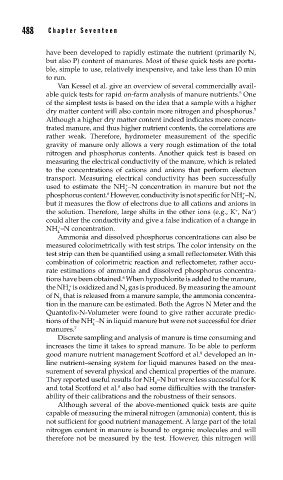Page 516 - Biosystems Engineering
P. 516
488 Cha pte r Se v e ntee n
have been developed to rapidly estimate the nutrient (primarily N,
but also P) content of manures. Most of these quick tests are porta-
ble, simple to use, relatively inexpensive, and take less than 10 min
to run.
Van Kessel et al. give an overview of several commercially avail-
5
able quick tests for rapid on-farm analysis of manure nutrients. One
of the simplest tests is based on the idea that a sample with a higher
dry matter content will also contain more nitrogen and phosphorus.
5
Although a higher dry matter content indeed indicates more concen-
trated manure, and thus higher nutrient contents, the correlations are
rather weak. Therefore, hydrometer measurement of the specific
gravity of manure only allows a very rough estimation of the total
nitrogen and phosphorus contents. Another quick test is based on
measuring the electrical conductivity of the manure, which is related
to the concentrations of cations and anions that perform electron
transport. Measuring electrical conductivity has been successfully
+
used to estimate the NH –N concentration in manure but not the
4
+
6
phosphorus content. However, conductivity is not specific for NH –N,
4
but it measures the flow of electrons due to all cations and anions in
the solution. Therefore, large shifts in the other ions (e.g., K , Na )
+
+
could alter the conductivity and give a false indication of a change in
+
NH –N concentration.
4
Ammonia and dissolved phosphorus concentrations can also be
measured colorimetrically with test strips. The color intensity on the
test strip can then be quantified using a small reflectometer.With this
combination of colorimetric reaction and reflectometer, rather accu-
rate estimations of ammonia and dissolved phosphorus concentra-
6
tions have been obtained. When hypochlorite is added to the manure,
+
the NH is oxidized and N gas is produced. By measuring the amount
4 2
of N that is released from a manure sample, the ammonia concentra-
2
tion in the manure can be estimated. Both the Agros N Meter and the
Quantofix-N-Volumeter were found to give rather accurate predic-
+
tions of the NH –N in liquid manure but were not successful for drier
4
manures. 7
Discrete sampling and analysis of manure is time consuming and
increases the time it takes to spread manure. To be able to perform
8
good manure nutrient management Scotford et al. developed an in-
line nutrient–sensing system for liquid manures based on the mea-
surement of several physical and chemical properties of the manure.
They reported useful results for NH –N but were less successful for K
4
and total Scotford et al. also had some difficulties with the transfer-
8
ability of their calibrations and the robustness of their sensors.
Although several of the above-mentioned quick tests are quite
capable of measuring the mineral nitrogen (ammonia) content, this is
not sufficient for good nutrient management. A large part of the total
nitrogen content in manure is bound to organic molecules and will
therefore not be measured by the test. However, this nitrogen will

